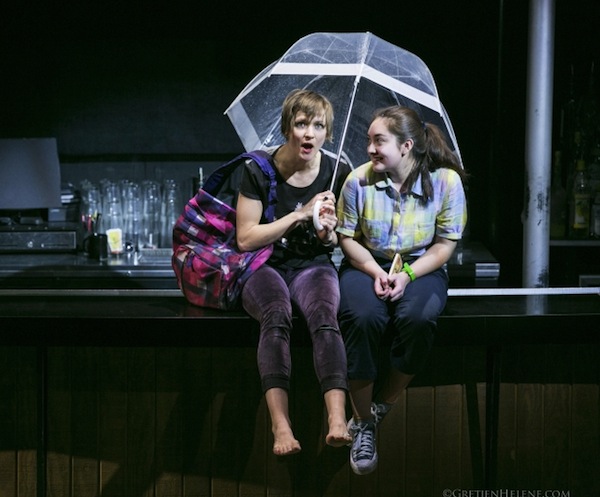Dance Review: “The Shape She Makes” — A Complex, Eloquent Hybrid of Dance and Theater
“The Shape She Makes” proffers an eloquent fusion of language and movement that pushes the boundaries of dance and theater without embracing the opaqueness that marks so many experimental productions.
The Shape She Makes. Conceived by Jonathan Bernstein and Susan Misner. Choreographed by Misner, and written and directed Bernstein. Music by Julia Kent and Son Lux. presented by the American Repertory Theater at Oberon, Cambridge, MA, through April 27.

Mary Cavett and Sydney K. Penny in “The Shape She Makes” at the American Repertory Theater. Photo: Gretjen Helene Photography.
By Iris Fanger
Martha Graham’s belief that “movement never lies” could serve as a viewer’s mantra for The Shape She Makes, the fascinating dance-theater piece now receiving its world premiere production at the American Repertory Theater’s Oberon space in Cambridge. Co-conceived by choreographer Susan Misner and her life-partner, writer-director Jonathan Berstein, the work is a musical, but it is like few others we have seen. None of the ten members of the cast, led by Misner in the leading role, burst into song, nor does the action stop when the dancers begin shape-changing into characters as varied as armoires, refrigerator doors, or belligerent lovers. The dance carries the thrust of the story as much as the dialogue, often in tandem.
I could not help but remember the pompous adage “As the twig is bent, so grows the tree” while watching this non-linear story unfold. The action follows the story of a family, but it skips backwards and forwards in time. Young girl Quincy, who longs for her absent father, Bernard, lives with her mother, Louise, who is indifferent to her feelings. When we first see Quincy, she is a soft-spoken, observant child of 11 gifted with a precocious talent for math. The show follows her growth into middle age, ricocheting through time, from Quincy’s birth, when Louise and Bernard were sharing a loving relationship, to Louise’s bitterness after Quincy’s father abandons them, to what passes for Quincy’s adult life as a care-giver for her mother. The effective score, composed by Julia Kent and Son Lux, creates an aural atmosphere which envelops the action, never coming off as a crutch for the movement or a prod for the story-telling.
To Bernstein’s credit, the dialogue eschews clichés, even though the bare skeleton of the plot could have been cribbed from a TV-soap opera. The underlying theme underscores a commonplace: each of us is shaped from birth by how we were nurtured by our parents. However, driven by the combination of Misner’s inventive choreography and Bernstein’s script, the 90-minute-long work is more than the sum of its truisms. The production left some members of the audience — this writer included — in tears at the sad inevitability of the ending.
Presented in shifting sequences throughout the space, Misner’s movements for her cast of A-list dancer-actors (who trail lists of extensive New York credits) are generated from an inventive combination of mime and classical techniques, gestures and stunning lifts. The actors come in different sizes and ages, unlike the ordinary chorus line cuties. When not on stage, they take chairs and sit among the audience members, who are scattered three-quarters around the playing space.
Misner has made her reputation in recent years as an actress with dozens of television and screen credits. (She is currently appearing in the FX series, The Americans as Sandra Beeman, the wife of the FBI agent.) Starting her professional career at age 17 as a hoofer, she graduated to Broadway shows where she worked with masters such as Rob Marshall, Wayne Cilento, and Christopher Chadman. At age 25, she studied acting and changed the course of her career.
However, as Louise, both older and younger versions, Misner is a marvel of expressivity. When she portrays a young woman in love with Bernard, she performs a pointy finger, prancing dance, joyously striding over his body in a wide second position. Later, the relationship gone sour, the same movement turns tense — it is stretched as if the gesture is being forced out of her. The gifted 13-year old actor Sydney Penney, a Needham eighth grader, appears as the young Quincy, anxious to please yet desperate for the information that will help her understand her troubling living conditions. Finnerty Steeves as the older Quincy is a marvel of sensitivity, pain, and smarts who cannot change direction even once she understands how her identity was shaped.
Although Misner has found success as an actor, it seems abundantly clear from this piece that she should be creating musical theater. The Shape She Makes proffers an eloquent fusion of language and movement, a story-telling that pushes the boundaries of dance and theater without embracing the opaqueness that marks so many experimental productions. A.R.T. is to be congratulated for sponsoring this production, which is sure to have a life beyond its current in Cambridge.
Iris Fanger is a theater and dance critic based in Boston. She has written reviews and feature articles for the Boston Herald, Boston Phoenix, Christian Science Monitor, New York Times, and Patriot Ledger as well as for Dance Magazine and Dancing Times (London).
Former director of the Harvard Summer Dance Center, 1977-1995, she has taught at Lesley Graduate School and Tufts University, as well as Harvard and M.I.T. She received the 2005 Dance Champion Award from the Boston Dance Alliance and in 2008, the Outstanding Career Achievement Award from the Graduate School of Arts and Sciences at Tufts. She lectures widely on dance and theater history.
